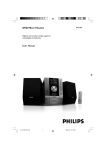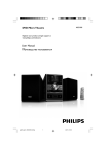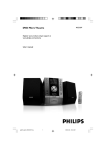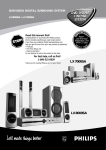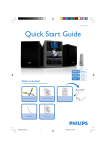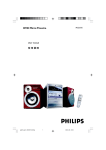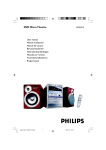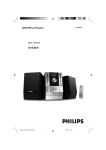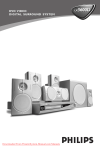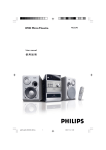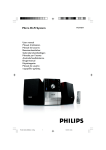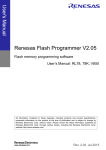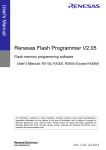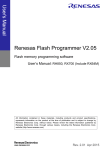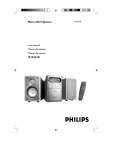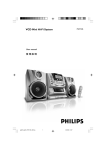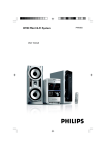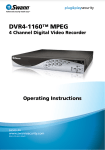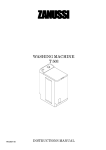Download Philips MCD396 DVD DVD Micro Theater
Transcript
MCD396 DVD Micro Theater Register your product and get support at www.philips.com/welcome pg001-pg041_MCD396-Eng 1 5/13/09, 15:20 CAUTION Visible and invisible laser radiation. If the cover is open, do not look at the beam. 2 pg001-pg041_MCD396-Eng 2 5/13/09, 15:20 $ 1 # 2 3 4 5 @ ! 0 9 8 6 7 3 pg001-pg041_MCD396-Eng 3 5/13/09, 15:20 1 4 $ ¡ 5 8 7 9 TAPE USB/AUX ) ^ 6 7 8 & @ # * 0 ! ( ™ £ % ≤ 2 3 4 pg001-pg041_MCD396-Eng 4 5/13/09, 15:20 Manufactured under license from Dolby Laboratories. "Dolby", "Pro Logic" and the double-D symbol are trademarks of Dolby Laboratories. MANUFACTURED UNDER LICENSE FROM DIGITAL THEATER SYSTEMS, INC. US PAT. NO 5,451,942,5,956,674, 5,974,380, 5,978,762 AND OTHER WORLDWIDE . PATENTS ISSUED AND PENDING. "DTS" AND "DTS DIGITAL SURROUND" ARE RESISTERED TRADEMARKS OF DIGITAL THEATER SYSTEMS, INC. COPYRIGHT 1996, 2000 DIGITAL THEATER SYSTEMS, INC. ALL RIGHTS RESERVED. CAUTION Use of controls or adjustments or performance of procedures other than herein may rusult in hazardous radiation exposure or other unsafe operation. This product incorporates copyright protection technology that is protected by method claims of certain U.S. patents and other intellectual property rights owned by Macrovision Corporation and other rights owners. Use of this copyright protection technology must be authorized by Macrovision Corporation, and is intended for home and other limited viewing uses only unless otherwise authorized by Macrovision Corporation. Reserve engineering or disassembly is prohibited. DivX, DivX Certified, and associated logos are trademarks of DivXNetworks, Inc and are used under license. Windows Media is a trademark of Microsoft Corporation. 5 pg001-pg041_MCD396-Eng 5 5/13/09, 15:20 English Index English ------------------------------------------------ 8 -------------------------------------------------------- 45 7 pg001-pg041_MCD396-Eng 7 2008.6.24, 3:31 PM Language Code Inupiaq Irish Íslenska Italiano Ivrit Japanese Javanese Kalaallisut Kannada Kashmiri Kazakh Kernewek Khmer Kinyarwanda Kirghiz Komi Korean Kuanyama; Kwanyama Kurdish Lao Latina Latvian Letzeburgesch; Limburgan; Limburger Lingala Lithuanian Luxembourgish; Macedonian Malagasy Magyar Malayalam Maltese Manx Maori Marathi Marshallese Moldavian Mongolian Nauru Navaho; Navajo Ndebele, North Ndebele, South Ndonga Nederlands Nepali Norsk Northern Sami North Ndebele Norwegian Nynorsk; Occitan; Provencal Old Bulgarian; Old Slavonic Oriya Oromo Ossetian; Ossetic Pali Panjabi Persian Polski Português Abkhazian 6566 Afar 6565 Afrikaans 6570 Amharic 6577 Arabic 6582 Armenian 7289 Assamese 6583 Avestan 6569 Aymara 6589 Azerhaijani 6590 Bahasa Melayu 7783 Bashkir 6665 Belarusian 6669 Bengali 6678 Bihari 6672 Bislama 6673 Bokmål, Norwegian 7866 Bosanski 6683 Brezhoneg 6682 Bulgarian 6671 Burmese 7789 Castellano, Español 6983 Catalán 6765 Chamorro 6772 Chechen 6769 Chewa; Chichewa; Nyanja 7889 9072 Chuang; Zhuang 9065 Church Slavic; Slavonic 6785 Chuvash 6786 Corsican 6779 Česky 6783 Dansk 6865 Deutsch 6869 Dzongkha 6890 English 6978 Esperanto 6979 Estonian 6984 Euskara 6985 6976 Faroese 7079 Français 7082 Frysk 7089 Fijian 7074 Gaelic; Scottish Gaelic 7168 Gallegan 7176 Georgian 7565 Gikuyu; Kikuyu 7573 Guarani 7178 Gujarati 7185 Hausa 7265 Herero 7290 Hindi 7273 Hiri Motu 7279 Hrwatski 6779 Ido 7379 Interlingua (International)7365 Interlingue 7365 7375 7165 7383 7384 7269 7465 7486 7576 7578 7583 7575 7587 7577 8287 7589 7586 7579 7574 7585 7679 7665 7686 7666 7673 7678 7684 7666 7775 7771 7285 7776 7784 7186 7773 7782 7772 7779 7778 7865 7886 7868 7882 7871 7876 7869 7879 8369 7868 7878 7967 6785 7982 7977 7983 8073 8065 7065 8076 8084 Pushto Russian Quechua Raeto-Romance Romanian Rundi Samoan Sango Sanskrit Sardinian Serbian Shona Shqip Sindhi Sinhalese Slovensky Slovenian Somali Sotho; Southern South Ndebele Sundanese Suomi Swahili Swati Svenska Tagalog Tahitian Tajik Tamil Tatar Telugu Thai Tibetan Tigrinya Tonga (Tonga Islands) Tsonga Tswana Türkçe Turkmen Twi Uighur Ukrainian Urdu Uzbek Vietnamese Volapuk Walloon Welsh Wolof Xhosa Yiddish Yoruba Zulu 6 pg001-pg041_MCD396-Eng 6 5/13/09, 15:20 8083 8285 8185 8277 8279 8278 8377 8371 8365 8367 8382 8378 8381 8368 8373 8373 8376 8379 8384 7882 8385 7073 8387 8383 8386 8476 8489 8471 8465 8484 8469 8472 6679 8473 8479 8483 8478 8482 8475 8487 8571 8575 8582 8590 8673 8679 8765 6789 8779 8872 8973 8979 9085 Contents English General Information Features ................................................................ 10 Discs for playback .............................................. 10 Supplied accessories .......................................... 10 Environmental information .............................. 11 Care and safety information ............................ 11 Hearing Safety ..................................................... 12 Connections Step 1: Placing speakers .................................... 13 Step 2: Connecting speakers ............................ 14 Step 3: Antenna connection ............................. 14 Step 4: Connecting TV ................................. 14-15 Using Video In jack Using S-Video In jack Using an accessory RF modulator Step 5: Connecting the power cord ............... 16 Optional: Connecting additional equipment 16 Controls Controls on the system .................................... 17 Controls on the remote control .............. 17-18 Preparations Before using the remote control .................... 19 Replacing battery ................................................ 19 Step 1: Setting the clock ................................... 19 Step 2: Setting video preference ............... 20-21 Step 3: Setting language preference ................ 21 Basic Functions Switching the system on ................................... 22 Switching the system to Eco Power Standby mode ..................................................................... 22 Power-saving automatic standby ..................... 22 Sound control ..................................................... 22 DBB DSC LOUDNESS Volume control ................................................... 22 Disc Operations Playing discs ......................................................... 23 Using the disc menu .......................................... 23 Basic playback controls ............................... 23-25 Pausing playback Selecting a track/chapter/title Resuming playback from the last stopped point Zoom Repeat and shuffle modes Repeat A-B Program Forward/Reverse Searching Time search & search by chapter/track number Information display during playback Special disc features ........................................... 25 Playing a Title Camera Angle Changing the Audio Language Changing the Audio Channel Subtitles Playing MP3 disc .................................................. 26 General operation Playback selection Playing JPEG Picture CD ................................... 26 General operation Playback selection Playing mixed-mode disc (for example, a disc contains MP3, photo and MPEG files) ........... 26 Photo file playback MPEG file playback Special JPEG features ......................................... 27 Zoom picture Slide show playback modes Playback with multi-angles Playing a DivX disc ............................................. 27 8 pg001-pg041_MCD396-Eng 8 5/13/09, 15:20 System Menu Options Basic operations ................................................. 28 SYSTEM SETUP ............................................ 28-30 TV SYSTEM SCREEN SAVER TV TYPE PASSWORD RATING DEFAULT DIVX(R) VOD registration code LANGUAGE SETUP .......................................... 30 VIDEO SETUP .................................................... 30 BRIGHTNESS CONTRAST HUE SATURATION AUDIO SETUP ............................................. 30-31 DIGITAL OUT DOWNMIX 3D PROCESSING LPCM NIGHT MODE General information on recording ................. 35 Preparation for recording ................................ 35 Synchro start CD recording ............................ 36 One touch recording ......................................... 36 Clock/Timer Clock setting ....................................................... 37 Timer setting ....................................................... 37 Sleep timer setting ............................................. 37 Specifications ........................................... 38 Troubleshooting .............................. 39-41 Glossary ......................................................... 42 Radio Reception Tuning to radio stations .................................... 32 Programming radio stations ............................. 32 Automatic programming ............................... 32 Manual programming ...................................... 32 Tuning to preset radio stations ....................... 32 USB Using a USB mass storage device ............. 33-34 Playing a USB mass storage device Tape Operation/Recording Tape playback ...................................................... 35 9 pg001-pg041_MCD396-Eng 9 5/13/09, 15:20 English Contents General Information English Congratulations on your purchase and welcome to Philips! To fully benefit from the support that Philips offers, register your product at www.philips.com/welcome. Features Additional Component Connections Lets you connect other audio and audio/visual components to the system so you can use the system’s surround sound speakers. Parental control (rating level) Lets you set a rating level so that your children cannot watch a DVD that has a rating higher than you set. Sleep timer Enables the system to switch to standby mode automatically at a preset time. Night Mode Lets you compress the dynamic range, reducing the difference in loudness between different sounds in Dolby Digital mode. The following formats can’t be supported • The files like *.VMA, *.AAC, *.DLF, *.M3U, *.PLS, *.WAV, • The discs recorded under Joliet format Region Codes DVDs must be labeled for ALL regions or Region 3 in order to play on this DVD system. You cannot play discs that are labeled for other regions. ALL 3 Discs for playback Your DVD System will play: – Digital Video Discs (DVDs) – Video CDs (VCDs) – Super Video CDs (SVCDs) – Digital Video Discs + Rewritable (DVD+RW) – Compact Discs (CDs) – Picture (Kodak, JPEG) files on CDR(W) – Windows Media Audio (WMA) – DivX(R) disc on CD-R(W): – DivX 3.11, 4.x and 5.x – Supported MP3-CD format. • ISO 9660 / UDF format • Max. title/album name –10 characters • Max. title number plus album is 255. • Max. nested directory is 8 levels. • The max. album number is 32. • The max. MP3 track number is 999. • Supported sampling frequencies for MP3 disc: 32 kHz, 44.1 kHz, 48 kHz. • Supported Bit-rates of MP3 disc are: 32, 64, 96, 128, 192, 256 (kbps). Notes: – For mixed mode discs, only one mode will be selected for playback according to the recording format. – If you are having trouble playing a certain disc, remove the disc and try a different one. Improperly formatted discs will not play on this system. – DTS surround audio output is not available in this DVD player. Supplied accessories – Composite video cable (yellow) – FM wire antenna – Remote Control with battery – This instruction booklet and a quick start guide 10 pg001-pg041_MCD396-Eng 10 5/13/09, 15:20 Environmental information Any unnecessary packaging has been omitted. We have tried to make the packaging easy to separate into three materials: cardboard (box), polystyrene foam (buffer) and polyethylene (bags, protective foam sheet). Your system consists of materials which can be recycled and reused if disassembled by a specialised company. Please observe the local regulations regarding the disposal of packaging materials, exhausted batteries and old equipment. ● The lens may cloud over when the player is suddenly moved from cold to warm surroundings, making it impossible to play a disc. Leave the player in the warm environment until the moisture evaporates. Do not block the vents ● Do not operate the system in an enclosed cabinet and allow about 10 cm (4 inches) of free space all around the player for adequate ventilation. 10 cm (4 inches) Care and safety information Avoid high temperatures, moisture, water and dust ● Where the MAINS plug or an appliance coupler is used as the disconnet device, the disconnet device shall remain readily operable. ● Install the unit near the AC outlet and where the AC power plug can be easily reached. ● Do not expose the system, batteries or discs to humidity, rain, sand or excessive heat (caused by heating equipment or direct sunlight). Always keep disc trays closed to avoid dust buildup on the lens. ● No objects filled with liquids, such as vases, shall be placed on the apparatus. ● No naked flame sources, such as lighted candles, should be placed on the apparatus. ● The apparatus shall not be exposed to dripping or splashing. ● When the system is switched to Standby mode, it is still consuming some power. To disconnect the system from the power supply completely, remove the AC power plug from the wall socket. Avoid condensation problem 10 cm (4 inches) DVD Micro Hi-Fi System 10 cm (4 inches) ● The ventilation should not be impeded by covering the ventilation openings with items, such as newspapers table-cloths, curtains, etc. Cleaning the cabinet ● Use soft cloth slightly moistened with a mild detergent solution. Do not use a solution containing alcohol, spirits, ammonia or abrasives. Cleaning discs ● To clean a CD, wipe it in a straight line from the center towards the edge using soft and lint-free cloth. A cleaning agent may damage the disc. ● Write only on the printed side of a CDR(W) and only with a soft felt-tipped pen. ● Handle the disc by its edge. Do not touch the surface. Cleaning the disc lens ● After prolonged use, dirt or dust may accumulate at the disc lens. To ensure good playback quality, clean the disc lens with Philips CD Lens Cleaner or any commercially available cleaner. Follow the instructions supplied with cleaner. 11 pg001-pg041_MCD396-Eng 11 5/13/09, 15:20 English General Information/Maintenance General Information/Maintenance English Hearing Safety Finding a suitable location ● Place the player on a flat, hard, stable surface. ● Install this unit near the AC outlet and where the AC power plug can be reached easily. Cleaning the head and the tape paths ● To ensure good recording and playback quality, clean the head A, the capstan(s) B, and pressure roller(s) C after every 50 hours of tape operation. ● Use a cotton swab slightly moistened with cleaning fluid or alcohol. ● You also can clean the head by playing a cleaning tape once. Listen at a moderate volume. ● Using headphones at a high volume can impair your hearing. This product can produce sounds in decibel ranges that may cause hearing loss for a normal person, even for exposure less than a minute. The higher decibel ranges are offered for those that may have already experienced some hearing loss. ● Sound can be deceiving. Over time your hearing "comfort level" adapts to higher volumes of sound. So after prolonged listening, what sounds "normal" can actually be loud and harmful to your hearing. To guard against this, set your volume to a safe level before your hearing adapts and leave it there. To establish a safe volume level: ● Set your volume control at a low setting. C B A B C Demagnetising the head ● Use a demagnetising tape available at your dealer. ● Slowly increase the sound until you can hear it comfortably and clearly, without distor tion. Listen for reasonable periods of time: ● Prolonged exposure to sound, even at normally "safe" levels, can also cause hearing loss. ● Be sure to use your equipment reasonably and take appropriate breaks. Be sure to observe the following guidelines when using your headphones. ● Listen at reasonable volumes for reasonable periods of time. ● Be careful not to adjust the volume as your hearing adapts. ● Do not turn up the volume so high that you can't hear what's around you. ● You should use caution or temporarily discontinue use in potentially hazardous situations. ● Do not use headphones while operating a motorized vehicle, cycling, skateboarding, etc.; it may create a traffic hazard and is illegal in many areas. 12 pg001-pg041_MCD396-Eng 12 5/13/09, 15:20 English Connections FM wire antenna Speaker (left) 110127v Speaker (right) 220240v R L + – SPEAKER 4Ω AC power cord IMPORTANT! – The type plate is located at the rear of the system. – Before connecting the AC power cord to the wall outlet, ensure that all other connections have been made. – Never make or change any connections with the power switched on. – High voltage! Do not open.You run the risk of getting an electric shock. – The machine does not contain any userserviceable parts. – Modification of the product could result in hazardous radiation of EMC or other unsafe operation. To avoid overheating of the system, a safety circuit has been built in.Therefore, your system may switch to Standby mode automatically under extreme conditions. If this happens, let the system cool down before reusing it (not available for all versions). Step 1: Placing speakers Front speaker ( right ) Front speaker ( left ) VIEWING AREA Place the front left and right speakers at equal distances from the TV set and at an angle of approximately 45 degrees from the listening position. Notes: – To avoid magnetic interference, do not position the front speakers too close to your TV set. – Allow adequate ventilation around the DVD System. 13 pg001-pg041_MCD396-Eng 13 5/13/09, 15:20 Connections English Step 2: Connecting speakers 1 Step 4: Connecting TV IMPORTANT! – You only need to make one video connection from the following options, depending on the capabilities of your TV system. – Connect the DVD system directly to the TV. 2 Connect the speaker wires to the SPEAKER terminals, right speaker to "R" and left speaker to "L", coloured (marked) wire to "+" and black (unmarked) wire to "-". Fully insert the stripped portion of the speaker wire into the terminal as shown. Notes: – Ensure that the speaker cables are correctly connected. Improper connections may damage the system due to short-circuit. – For optimal sound performance, use the supplied speakers. – Do not connect more than one speaker to any one pair of +/- speaker terminals. – Do not connect speakers with an impedance lower than the speakers supplied. Please refer to the SPECIFICATIONS section of this manual. Using Video In jack (CVBS) R SPEAKER 4Ω 1 Step 3: Antenna connection Connect the supplied FM antenna to the respective terminals. Adjust the position of the antenna for optimal reception. FM Antenna L + – 2 Use the composite video cable (yellow) to connect the system's VIDEO jack to the video input jack (or labelled as A/V In, Video In, Composite or Baseband) on the TV set. To hear the sound of this DVD Player through your TV, use the audio cables (white/red-not supplied) to connect LINE OUT (L/R) jacks of the DVD Player to the corresponding AUDIO IN jacks on the TV. Using S-Video In jack ● For better FM stereo reception, connect an outdoor FM antenna to the FM AERIAL (FM ANTENNA) terminal. R L + – SPEAKER 4Ω 14 pg001-pg041_MCD396-Eng 14 5/13/09, 15:20 1 2 Use the S-Video cable (not supplied) to connect the system's S-VIDEO jack to the S-Video input jack (or labelled as Y/C or S-VHS) on the TV set. To hear the sound of this DVD Player through your TV, use the audio cables (white/red-not supplied) to connect LINE OUT (L/R) jacks of the DVD Player to the corresponding AUDIO IN jacks on the TV. Using an accessory RF modulator IMPORTANT! – If your TV set only has a single Antenna In jack (or labelled as 75 ohm or RF In), you will need a RF modulator in order to view the DVD playback via TV. See your electronics retailer or contact Philips for details on RF modulator availability and operations. RF coaxial cable to TV TO TV VIDEO AUDIO IN IN R L ANT IN CH3 CH4 Antenna or Cable TV signal 1 Back of RF Modulator (example only) Use the composite cable (yellow) to connect the system's VIDEO jack to the video input jack on the RF modulator. 2 Use an RF coaxial cable (not supplied) to connect the RF modulator to your TV's RF jack. 15 pg001-pg041_MCD396-Eng 15 5/13/09, 15:20 English Connections Connections English Step 5: Connecting the power cord the front panel to select AUX or press AUX on the remote in order to activate the input source. IMPORTANT! – Never make or change any connection with the power switched on. Note: – If you are connecting equipment with a mono output (a single audio out terminal), connect it to the AUX left terminal. Alternatively, you can use a “single to double” cinch cable (the output sound still remain mono). After everything is connected properly, plug in the AC power cord to the power outlet. If your system is equipped with a Voltage Selector, set the VOLTAGE SELECTOR to the local power line voltage. Optional: Connecting additional equipment IMPORTANT! – Some discs are copy-protected.You cannot record the disc through a VCR or digital recording device. – When making connections, make sure the colour of cables matches the colour of jacks. – Always refer to the owner's manual of the other equipment for complete connection and usage details. AUDIO OUT L R A Listening to the playback of other equipment A Use a cinch cable (not supplied) to connect LINE-IN on the front panel of the DVD player to the analogue audio out terminals of an external equipment (TV, VCR, Laser Disc player, DVD player or CD Recorder). Before starting operation, press SOURCE on C DIGITAL IN VIDEO IN AUDIO INPUT AUDIO IN R D + – 16 B L R SPEAKER 4Ω Using the VCR for recording DVDs B Connect one of the system's VIDEO OUT jacks to the corresponding VIDEO IN jack and LINE OUT (R/L) jacks to the AUDIO IN jacks on the VCR. This will allow you to make analogue stereo (two channel, right and left) recordings. Recording (digital) C Connect the system's COAXIAL jack to the DIGITAL IN jack on a digital recording device (such as DTS-Digital Theatre compatible, with Dolby Digital decoder). Before star ting operation, set the DIGITAL OUT according to the audio connection. (See "DIGITAL OUT".) Connecting an active subwoofer D Connect the DVD micro system's SUBWOOFER OUT jack to the AUDIO INPUT jack on an active subwoofer (not supplied). 16 pg001-pg041_MCD396-Eng L 5/13/09, 15:20 Controls on the system – 1 iR sensor – infrared sensor for remote control. 2 STANDBY-ON y – ! LOUDNESS/DBB – @ switches the system on or standby mode. 3 CLOCK – # Standby mode sets the system clock. Playback mode – displays track information. 4 OPEN•CLOSE 0 – to open or close the disc door. – – $ 5 Mode Selection – – – 9 ............................. In DISC/USB mode, to stop playback or clear a program. 2; ........................... In DISC/USB mode, to start or interrupt playback. PRESETí/ë ................................. Disc/USB: skips to the previous/ next chapter/title/track. ................................. Tuner: selects a preset radio station. TUNING 22/33 Tuner press to tune to a lower/higher radio frequency gradually. press and hold, then release the key to start automatic search for a radio frequency downward/upward. Disc/USB searches fast backward/forward in a disc/USB. 6n – to connect a headphone. 7 USB port – jack for the external USB mass storage device 8 LINE-IN jack – to connect an auxiliary device. 9 VOL – adjusts the volume upward/downward. – adjusts the hours and minutes in clock/timer setting mode. 0 DSC – selects different types of preset sound equalizer settings (CLASSIC, JAZZ, POP or ROCK). enables or disables automatic loudness adjustment. enables or disables bass enhancement. SOURCE to select the respective sound source : DISC TUNER, TAPE, USB or AUX. Display screen to view the current status of the system. Tape Deck Operation RECORD● ... starts recording. PLAY 2 ............ starts playback. REW/F.FWD à / á ................................. fast rewinds/winds the tape. STOP•OPENÇ0 ................................. stops tape playback/recording; opens the tape compartment. PAUSEÅ ....... interrupts recording or playback. Controls on the remote control 1y – to switch to the system to standby mode. 2 Numeric Keypad (0-9) – inputs a track/title/chapter number of the disc. 3 PROG/ANGLE – – – – 4 – 5 – DVD/VCD/CD/MP3-CD/USB: enters the program menu. Picture CD: during playback, to select a slide show mode. Tuner: programs preset radio stations. DVD: selects a DVD camera angle. SOURCE to select the respective sound source : DISC TUNER, TAPE, USB or AUX. SYSTEM MENU (disc mode only) to enter or exit the system menu bar. 17 pg001-pg041_MCD396-Eng 17 5/13/09, 15:20 English Controls Controls English 6 DISC MENU (disc mode only) – – DVD/VCD: enters or exits the disc contents menu. VCD2.0: switches the playback control mode on or off . – – – Tuner press to tune to a lower/higher radio frequency gradually. press and hold, then release the key to start automatic search for a radio frequency downward/upward. Disc (not for MP3 CD) searches backward/forward in a disc at different speeds. In DISC mode, to select a movement direction in the disc menu or system menu bar. 8 3/4 – In DISC mode, to select a movement direction in the disc menu or system menu bar. 9 OK – – – – Standby mode sets a time for switching on the system automatically. Playback mode sets the sleep timer function (auto-off). LOUD/DBB enables or disables automatic loudness adjustment. enables or disables bass enhancement. * DSC – selects different types of preset sound equalizer settings (CLASSIC, JAZZ, POP or ROCK). ( MUTE to interrupt or resume sound reproduction. – ) – DISPLAY for disc selects a disc information display mode. ¡ REPEAT A-B – – to exit or confirm the selection. for VCD/CD: to repeat a specific section within the same track. for DVD: to repeat a specific section in a disc. ™ AUDIO 0 í/ë – – & 7 22/33 – – Disc: skips to the previous/next chapter/title/ track. Tuner: selects a preset radio station. – for VCD sets Stereo, Mono-Left or Mono-Right sound mode. for DVD selects an audio language. !9 – – £ ZOOM In DISC mode, to stop playback or clear a program. – @ 2; – In DISC mode, to start or interrupt playback. – – adjusts the volume upward/downward. adjusts the hours and minutes in clock/timer setting mode. $ MODE – to select various repeat modes or the shuffle play mode for a disc. % SUBTITLE – selects a subtitle language. ^ SLEEP/TIMER ≤ GOTO – # VOL +/- DVD/VCD/Picture CD: enlarges or reduces a picture or active image on the TV screen. In DISC mode, to fast search in a disc by entering a time, title, chapter or track. Notes for remote control: – First, select the source you wish to control by pressing one of the source select keys on the remote control (DISC or TUNER, for example). – Then select the desired function ( 2;, í, ë for example). 18 pg001-pg041_MCD396-Eng 18 5/13/09, 15:20 IMPORTANT! – Make sure to complete the preparation procedures before operating the system. Before using the remote control 1 2 3 Pull out the plastic protective sheet. Select the source you wish to control by pressing one of the source select keys on the remote control (for example CD, TUNER). Then select the desired function (for example ÉÅ , à , á). Remove the plastic protective sheet English Preparations Step 1: Setting the clock 1 2 Go to Standby mode. Press and hold CLOCK on the front panel. ➜ The hour digits flash on the display screen. 3 Turn the VOL control on the front panel or press VOL +/- on the remote to set the hours. 4 Press CLOCK again. ➜ The minute digits flash on the display screen. 5 Turn the VOL control on the front panel or press VOL +/- on the remote to set the minutes. 6 Press CLOCK to confirm the clock setting. Notes: – This system only supports 24-hour mode. – The clock setting will be erased when the system is disconnected from the power supply. – The system will exit clock setting mode if no button is pressed within 10 seconds. Replacing battery (lithium CR2025) into the remote control 1 2 3 Press the slot on the battery compartment. Pull out the battery compartment. Replace a new battery and fully insert the battery compartment back to the original position. 1 2 CR2025 3 CAUTION! Batteries contain chemical substances, so they should be disposed of properly. 19 pg001-pg041_MCD396-Eng 19 5/13/09, 15:20 Preparations English Step 2: Setting video preference PAL – If the connected TV is PAL system, select this mode. It will change the video signal of a NTSC disc and output in PAL format. IMPORTANT! – Make sure you have completed all the necessary connections. (See "Connections-Connecting TV".) AUTO – If the connected TV is multi system, select this mode.The output format will be in accordance with the video signal of the disc. – Setting TV TYPE Select the aspect ratio of the TV to be connected. Turn on the TV set and set it to the correct Video-In channel. ➜ You may go to channel 1 on your TV set, then press the channel button repeatedly until you see the Video In channel. ➜ Or, you can use the TV remote control to select different video modes. ➜ Or, set TV to channel 3 or 4 if you are using an RF modulator. 1 2 In stop mode or during playback, press SYSTEM MENU. Press 22/33/5/4 on the remote control to toggle through the functions and select your preferential option. 4:3 PS (Pan and Scan mode ) – If you have a conventional TV set and your DVD is not formatted for widescreen viewing, use this setting. A wide picture is displayed on the whole TV screen with a por tion automatically cut off. 4:3 LB (Letterbox mode ) – If you have a conventional TV set and your DVD is formatted for widescreen viewing, use this setting. A wide picture with bands displayed on the upper and lower portions of the TV screen. ➜ Move to SYSTEM SETUP and press 4. ➜ Move to one of the following and press 33. – Setting TV SYSTEM Allows you to select the colour system matching the connected TV set. NTSC – If the connected TV is NTSC system, select this mode. It will change the video signal of a PAL disc and output in NTSC format. 16:9 (Wide screen mode) – If you have a widescreen TV set, use this setting (you must also set your widescreen TV to “full size”) available on a disc, then the disc’s own preference will be used. 20 pg001-pg041_MCD396-Eng 20 5/13/09, 15:20 Note: The format you select must be available on the disc. If it is not, the setting for TV Type will not affect the picture during playback. OSD LANGUAGE (On-Screen Display) Switches the display language on the TV screen. Select the language from the displayed list. AUDIO LANG (DVD only) Switches the display language of the sound track. Select the language from the displayed list. To exit the menu Press SYSTEM MENU again. SUBTITLE LANG (DVD only) Switches the display language of the subtitle. Select the language from the displayed list. Step 3: Setting language preference MENU LANG (DVD only) Select the language for the DVD menu. You can select your preferred language settings so that this DVD Micro System will automatically switch to the language for you whenever you load a disc. If the language selected is not available on the disc, the language set by default will be used instead. But the menu language of the DVD Micro System cannot be changed once selected. When the selected language is not recorded in the DVD, one of the recorded languages will be selected automatically (except for OSD). You can reset all the DVD settings except for Rating. If the language selected is not available on the disc, the original language designated by each disc will be selected. 3 4 Press 5/4 to select a language and press OK. Repeat steps 2~3 for other settings. To exit the menu LATIN Press SYSTEM MENU again. 1 2 In stop mode or during playback, press SYSTEM MENU. Press 22/33/5/4 on the remote control to select your preferred option. ➜ Move to LANGUAGE SETUP and press 4. ➜ Move to one of the following and press 33. 21 pg001-pg041_MCD396-Eng 21 5/13/09, 15:21 English Preparations Basic Functions English Switching the system on ● Press STANDBY-ON B on the front panel. ➜ The system will switch to the last selected source. ● Press SOURCE repeatedly (or DISC, TUNER,TAPE, USB or AUX on the remote). ➜ The system will switch to the selected source. Power-saving automatic standby As a power-saving feature, the system will automatically switch to Standby mode if you do not press any buttons within 15 minutes after a disc has stopped playing. Sound Control DBB, DSC and LOUDNESS sound features cannot be activated at the same time. DBB (Dynamic Bass Boost) Volume control Turn the VOL control on the front panel clockwise or anticlockwise or press VOL +/- on the remote to increase or decrease the volume level. ➜ ”VOL XX” is displayed on the display panel. “XX” denotes the volume level. To listen through the headphone ● Connect the headphone plug to the n socket on the front panel of the DVD player. ➜ The speakers will be muted. To switch off the volume temporarily ● Press MUTE on the remote. ➜ Playback will continue without sound and “MUTE” appears. ● To activate sound reproduction, you can: – press MUTE again; – adjust the volume controls; – change source. DBB enhances the bass response. ● Press LOUDNESS/DBB on the front panel or press LOUD/DBB on the remote to enable/ disable DBB feature. ➜ Some discs might be recorded in high modulation, which causes a distortion at high volume. If this occurs, switch off DBB or reduce the volume. DSC (Digital Sound Control) DSC provides a different type of preset sound equalizer setting. ● Press DSC repeatedly to select: CLASSIC, JAZZ, POP or ROCK. LOUDNESS LOUDNESS feature enables the system to automatically increase the treble and bass sound effect at low volume (the higher the volume, the lower the treble and bass increase). ● Press LOUDNESS/DBB on the front panel or press LOUD/DBB on the remote to enable/ disable LOUDNESS feature. ➜ icon appears/disappears after this feature is enabled/disabled. 22 pg001-pg041_MCD396-Eng 22 5/13/09, 15:21 IMPORTANT! – This system is designed for regular discs. Therefore, do not use any accessories such as disc stabiliser rings or disc treatment sheets, etc., as offered on the market, because they may jam the disc mechanism. – Do not move the system during playback. Doing so may damage the system. – DVD discs and players are designed with regional restrictions. Before playing a disc, make sure the disc matches the regional code of your player. – According to the format requirement of DVD or VCD, some operations may be different or restricted. – Do not push on the disc tray or put any objects other than disc on the disc tray. Doing so may cause the disc player malfunction. – If “INVALID KEY” appears on the TV screen when a button is pressed, it means the function is not available on the current disc at the current time. Using the disc menu For disc with Table Of Contents, a menu may appear on the TV screen once you load the disc. To select a playback feature or item ● Use 22/33/5/4 and OK or Numeric Keypad (0-9) on the remote. ➜ Playback will start automatically. To access or exit the menu ● For VCD with Playback Control (PBC) feature (version 2.0 only) PBC playback allows you to play Video CDs interactively, following the menu on the display. ● During playback, press DISC MENU. ➜ If PBC was ON, it will switch to OFF and continue playback. ➜ If PBC was OFF, it will switch to ON and return to menu screen. Basic playback controls Pausing playback (DVD/VCD/CD/MP3 /WMA) Playing discs 1 2 3 4 5 6 Press DISC MENU on the remote. Connect the power cords of the system and TV (or any optional stereo or AV receiver) to a power outlet. Turn on the TV power and set to the correct Video In channel. (See "Setting up the TV".) Press STANDBY-ON 2 on the DVD Player front panel. ➜ You should see the blue Philips DVD background screen on the TV. Press OPEN/CLOSE 0 to open the disc door and load in a disc, then press the same button again to close the disc door. ➜ Make sure the label side is facing up. Playback will start automatically (depending on the disc type). ➜ If a disc menu appears on the TV, see "Using the Disc Menu". ➜ If the disc is locked by parental control, you must enter your four-digit password. (See "SYSTEM SETUP-PASSWORD".) At any time, simply press 9 to stop playback. 1 2 During playback, press 2;. ➜ Playback will pause and sound will be muted. Press 2; again to resume. Selecting a track/chapter/title (DVD/ VCD/CD/MP3/WMA) 1 2 Press PRESETí/ë during playback to go to the previous or next chapter/title/track. To go directly to any chapter/ title/track, enter the chapter/ title/track number using the Numeric Keypad (0-9). Resuming playback from the last stopped point (DVD/VCD/CD/MP3 /WMA) ● In stop mode and when a disc has not been removed, press 2;. To cancel resume mode ● In stop mode, press 9 again. 23 pg001-pg041_MCD396-Eng 23 5/13/09, 15:21 English Disc Operations Disc Operations English Zoom (DVD/VCD/JPEG) 1 2 Repeat A-B (DVD/VCD/CD/MP3/WMA) Zooming allows you to enlarge or reduce the video image during playback. Press ZOOM on the remote repeatedly to enlarge or reduce the playback video image. 1 Press REPEAT A-B at your chosen starting point. 2 Press REPEAT A-B again at your chosen end point. ➜ The section A and B can be set only within the same chapter/track. ➜ The section will now repeat continuously. 3 To exit the sequence, press REPEAT A-B again. ➜ “A-B CANCEL” is displayed on the TV screen. Press 22/33/5/4 to pan across the TV screen. Repeat and shuffle modes (DVD/VCD/CD/MP3/WMA/DivX) ● Press MODE repeatedly to choose a repeat mode during playback. Program (not for Picture CD) For DVD CHAPTER – to repeat playback of the current chapter. To select favourite tracks/chapters for playback in preferred sequence. TITLE – to repeat playback of the current title. ( Example for the DVD disc menu) OFF – switches off the repeat mode. For VCD/MP3/CD/DivX REP 1 – to repeat playback of the current track. REP DIR (for MP3 only) – to repeat playback of the current folder. REP ALL – to repeat playback of the whole disc. SHUF REP ALL ON – to repeat playback of the whole disc in random order. SHUF REP ALL OFF – switches off the repeat mode. 1 Press PROG/ANGLE on the remote control to enter the program mode. 2 On the remote control, press 22/33 to select desired sequence number. 3 On the remote control, press 5/4or use the Numerical Keypad (0-9) to select desired track ( T ), chapter ( C ) or album ( A ) or title ( T ). ● For MP3, after selecting desired album ( A ) number, press í/ë to go to track ( T ) position, then select desired track number. ● For DVD, after selecting desired title ( T ) number, press í/ë to go to chapter ( C ) position, then select desired chapter number. 4 Repeat steps 2-3 to program other track/ chapter/album/title. 5 6 7 After completing program, press OK. Press 22/33 to select PLAY. Press OK to start playback. 24 pg001-pg041_MCD396-Eng 24 5/13/09, 15:21 Special disc features Forward/Reverse Searching (DVD/VCD/ CD/MP3/WMA) 1 2 Press TUNING 22/33 during playback to select the required speed: X2, X4, X8 or X20 (backward or forward). ➜ Sound will be muted. To return to normal speed, press 2;. Time search & search by chapter/track number (DVD/VCD/CD/MP3/WMA/DivX) 1 2 Press GOTO until the time or chapter/track edit box appears. Enter hours, minutes and seconds from left to right in the time edit box using the Numeric Keypad (0-9) on the remote. OR Enter your desired chapter/track number in the chapter/track edit box using the Numeric Keypad (0-9) on the remote. Information display during playback (DVD/VCD/CD/MP3/WMA) ● During playback, press DISPLAY on the remotew to show disc information on the TV screen. English Disc Operations Playing a Title (DVD) 1 Press DISC MENU. ➜ The disc title menu appears on the TV screen. 2 3 Use 22/33/5/4 to select a play option. Press OK to confirm. Camera Angle (DVD) ● Press PROG/ANGLE on the remote repeatedly to select different desired angle. Changing the Audio Language (for DVD recorded with multiple languages) ● Press AUDIO on the remote repeatedly to select different audio languages. Changing the Audio Channel (for VCD only) ● Press AUDIO on the remote to select the available audio channels provided by the disc (Mono Left, Mono Right or Stereo). Subtitles (DVD) ● Press SUBTITLE on the remote repeatedly to select different subtitle languages. For DVD/VCD/CD ➜ Elapsed playback time of the current track/ title. ➜ Remaining playback time of the current track/ title. ➜ Elapsed playback time of the whole disc. ➜ Remaining playback time of the whole disc. ➜ Display off. For MP3 CD ➜ Elapsed playback time of the current track. ➜ Remaining playback time of the current track. 25 pg001-pg041_MCD396-Eng 25 5/13/09, 15:21 Disc Operations English Playing MP3/WMA/JPEG Disc IMPORTANT! – You have to turn on your TV and set to the correct Video In channel. (See "Setting up the TV".) Playing MP3/WMA disc General operation Playback selection During playback, you can: ● Press PRESETí/ë to select another file in the current folder. ● Use 22/33/5/4 on the remote to rotate/ flip the picture files. ● Press 2; repeatedly to pause/resume playback. ● Press 9 to stop playback and return to the disc content menu. Playing mixed-mode disc (for example, a disc contains MP3, photo and MPEG files) 1 2 3 You can play a mixed-mode disc through this DVD micro system. After loading of such a disc, a data disc menu will appear on the TV screen and playback will star t automatically from the MP3 files. The MP3 file operation is the same as that described above (see "Playing MP3/WMA disc"). Load an MP3/WMA disc. ➜ A data disc menu appears on the TV screen and playback starts automatically from the first track. Press 5/4 to select a directory. Press PRESETí/ë to select a track. Or directly use the Numeric Keypad (0-9) to select a track in the current directory. ➜ The playback will start from the selected track to the end of the directory. Notes: – Do not input a number larger than the number of tracks in the current directory. – The disc reading time may exceed 10 seconds due to large number of songs compiled onto the disc. Photo file playback 1 Press SUBTITLE, DISC MENU and 22/ 33 to select the icon and then press OK to select a photo directory. 2 Press 5 to enter the photo playback mode and press 5/4 to select a photo. 3 Press 2; or OK to play the photos sequentially starting from the one you selected. ● During sequential playback, press í/ë to select the next/previous photo, press 2; to pause, or press 9 to stop the playback. Playing JPEG Picture CD 1 2 3 MPEG file playback General operation 1 Load a JPEG Picture CD. ➜ A data disc menu appears on the TV screen and playback starts automatically from the first file. Press SUBTITLE, DISC MENU and 22/ icon and then press OK 33 to select the to select a MPEG directory 2 Press 5/4 / 22/33 to select a MPEG file and press OK to play this MPEG file. Press 5/4 to select a folder. ● At any time, simply press 9 to stop playback. Press PRESETí/ë to select a file. Or directly use the Numeric Keypad (0-9) to select a file in the current folder. ➜ The playback will start from the selected picture to the end of the folder. To return to MP3 playback mode again ● Press SUBTITLE and 22/33 to select the icon. 26 pg001-pg041_MCD396-Eng 26 5/13/09, 15:21 Special JPEG features Playing a DivX disc Zoom picture (JPEG) This DVD player supports the DivX movie playback that you download from your computer onto a CD-R/RW. Load a DivX disc. ● During playback, press ZOOM repeatedly to display the picture with different scales (X2, X3, X4, X1/2, X1/3 and X1/4). ● Use 22/33/5/4 to view the zoomed picture. Slide show playback modes (JPEG) ● During playback, press PROG/ANGLE repeatedly to select different slide-show playback modes: Mode 0: NONE Mode 1: WIPE TOP Mode 2: WIPE BOTTOM Mode 3: WIPE LEFT Mode 4: WIPE RIGHT Mode 5: DIAGONAL WIPE LEFT TOP Mode 6: DIAGONAL WIPE RIGHT TOP Mode 7: DIAGONAL WIPE LEFT BOTTOM Mode 8: DIAGONAL WIPE RIGHT BOTTOM Mode 9: EXTEND FROM CENTER H Mode 10: EXTEND FROM CENTER V Mode 11: COMPRESS TO CENTER H Mode 12: COMPRESS TO CENTER V Mode 13: WINDOW H Mode 14: WINDOW V Mode 15: WIPE FROM EDGE TO CENTER Mode 16: RANDOM 1 1 2 English Disc Operations PressÉÅon the remote control to start playack. If the DivX movie contains external subtitles, the subtitle menu will appear on the TV screen for your selection. ● In this case, pressing SUBTITLE on the remote control will turn on or off the subtitle. ● If multilingual subtitles are embedded on the DivX disc, pressing SUBTITLE will change the subtitle language during playback. Note: – Subtitle files with the following filename extensions (.srt, .smi, .sub, .ssa, .ass) are supported but do not appear on the file navigation menu. – The subtitle filename have to be the same as the filename of the movie. – For DivX discs, only subtitles in the following languages are supported: English and Chinese. Playback with multi-angles (JPEG) ● During playback, press 22/33/5/4 to rotate the picture on the TV screen. 5: flip the picture vertically. 4: flip the picture horizontally. 22: rotate the picture anti-clockwise. 33: rotate the picture clockwise. 27 pg001-pg041_MCD396-Eng 27 5/13/09, 15:21 System Menu Options English Basic operations 1 Press SYSTEM MENU to enter the Setup Menu. 2 3 4 5 Press 22/33 to select a page to be set. 6 Press 5/4 to highlight an option. Enter its submenu by pressing 33 or OK. Move the cursor by pressing 5/4 to highlight the selected item. ➜ In cases of value setting, press 5/4 to adjust values. Press OK to confirm. ➜ ON: In STOP, PAUSE or No DISC mode, if no actions are performed about 3 minutes, the screen saver will be activated. ➜ OFF: Screen saver is disabled. To return to the upper-level menu TV TYPE See "Preparations-Step 3: Setting video preference" for details. ● Press 22. To exit from the menu PASSWORD ● Press SYSTEM MENU again. ➜ The settings will be stored in the player’s memory even if the player is switched off. You can enter your four-digit password to activate or deactivate rating control. ➜" " is displayed if rating control is activated. ➜" " is displayed if rating control is deactivated. Note: – Some of the features in the System Menu Options are described in “Preparations”. SYSTEM SETUP The options included in SYSTEM SETUP page are: “TV SYSTEM”, “SCREEN SAVER”, “TV TYPE”, “PASSWORD”, “RATING”, “DEFAULT”and “DIVX(R) VOD”. To change password 1 Move to "PASSWORD" and press 33 or OK to enter its submenu. 2 DIVX(R) VOD TV SYSTEM See "Preparations-Step 3: Setting video preference" for details. SCREEN SAVER This function is used to turn the screen saver on or off. If " " is displayed, enter the default password (0000) and press OK to unlock. ● If " " is displayed, directly proceed with Step 3 and 4. 3 Enter your new four-digit password using Numeric Keypad (0-9) on the remote. 4 Press OK to confirm and the new password takes effect. Note: – The default password (0000) is always active even if the password has been changed. 28 pg001-pg041_MCD396-Eng 28 5/13/09, 15:21 4 PG 13 – Material is unsuitable for children under age 13. Parental Guidance suggested. RATING Some DVDs may have a parental level assigned to the complete disc or to certain scenes on the disc. This feature lets you set a playback limitation level. The rating levels are from 1 to 8 and are country dependent. You can prohibit the playing of certain discs that are not suitable for your children or have certain discs played with alternative scenes. 5-6 PG-R, R – Parental Guidance – Restricted; recommended that parents restrict children under 17 from viewing or allow them to view only when supervised by a parent or adult guardian. 7 NC-17 – No children under age 17; not recommended for children under age 17. 8 ADULT – Material for adults only; viewed only by adults due to graphic sexual scenes, violence, or language. DEFAULT Setting the “Default” function will reset all options and your personal settings to the factory defaults and all your personal settings will be erased. ● VCD, SVCD and CD have no level indication, so parental control function has no effect on those kinds of discs. This applies to most illegal DVD discs. 1 2 3 Press 5/4 to highlight “RATING”. Enter its submenu by pressing 33. Use 5/4 to highlight a rating level for the disc inserted. ➜ DVDs that are rated above the level you selected will not play unless you enter your fourdigit password and choose a higher level rating. Note: – Some DVDs are not encoded with a rating though the movie rating may be printed on the Disc cover.The rating level feature does not work for such Discs. Rating explanations 1 2 3 Press 5/4 to highlight “DEFAULT”. Highlight RESTORE by pressing 33. Press OK to confirm selection. Caution! – When this function is activated, all settings will be reset to factory defaults. 1 KID SAFE – Suitable for children. 2G – General Audience; recommended as acceptable for viewers of all ages. 3 PG – Parental Guidance suggested. 29 pg001-pg041_MCD396-Eng 29 5/13/09, 15:21 English System Menu Options System Menu Options English DIVX(R) VOD registration code ® 1 2 Philips provides you the DivX VOD (Video On Demand) registration code that allows you to rent and purchase videos using the DivX® VOD service. For more information, visit us at www.divx.com/ vod. In SYSTEM SETUP page, press 3 4 to highlight DIVX(R) VOD. ➜ The registration code will appear. Use the registration code to purchase or rent the videos from DivX® VOD service at www.divx.com/vod. Follow the instructions and download the video onto a CD-R for playback on this DVD player. Notes: – All the downloaded videos from DivX® VOD can only be played back on this DVD player. – Time search feature is not available during DivX movie playback. VIDEO SETUP The options included in VIDEO SETUP page are: "COMPONENT", "BRIGHTNESS", "CONTRAST", "HUE" and "SATURATION". BRIGHTNESS Adjusts the brightness level. Range: 0-12. CONTRAST Adjusts the contrast level. Range: 0-12. HUE Adjusts the hue level. Range: -6-+6. SATURATION Adjusts the saturation level. Range: 0-12. LANGUAGE SETUP The options included in LANGUAGE SETUP page are: "OSD LANGUAGE", "AUDIO LANG", "SUBTITLE LANG" and "MENU LANG". See "Preparations-Step 4: Setting language preference" for details. Note: The default settings of “COMPONENT” and “TV MODE” cannot be changed, which are “SVIDEO” and “INTERLACE” respectively. AUDIO SETUP The options included in AUDIO SETUP page are: "DIGITAL OUT", "DOWNMIX", "LPCM" and "NIGHT MODE". 30 pg001-pg041_MCD396-Eng 30 5/13/09, 18:10 English System Menu Options DIGITAL OUT ➜ DIGITAL/OFF: Turns off the digital output. ➜ DIGITAL OUT: If you have connected your DIGITAL OUT to a multi-channel decoder/ receiver. ➜ DIGITAL/PCM: Only if your receiver is not capable of decoding multi-channel audio. DOWNMIX These options allow you to set the stereo analogue output of your DVD Player. ➜ LT/RT: Select this option if your DVD Player is connected to a Dolby Pro Logic decoder. ➜ STEREO: Select this option when output delivers sound from only the two front speakers. LPCM If you connect the DVD Player to a PCM compatible receiver via the coaxial terminal, you may need to adjust 'LPCM'. Discs are recorded at a certain sampling rate. The higher the sampling rate, the better the sound quality. ➜ 48K: Playback a disc recorded at the sampling rate of 48kHz. ➜ 96K: Playback a disc recorded at the sampling rate of 96kHz. ➜ 192K: Playback a disc recorded at the sampling rate of 192kHz. NIGHT MODE ➜ OFF: Select this when you want to enjoy the surround sound with its full dynamic range. ➜ ON: Select this to level out the volume. High volume outputs will be softened and low volume outputs are brought upward to an audible level. This feature is only available for movies with Dolby Digital mode. 31 pg001-pg041_MCD396-Eng 31 5/13/09, 18:10 Radio Reception English TAPE APE Tuning to radio stations 1 Press SOURCE on the set or TUNER on the remote repeatedly until the desired waveband (FM) is displayed. 2 Press and hold TUNING 22/33 and release the button. ➜ The radio automatically tunes to a station with sufficient reception. 3 Repeat step 2 if necessary until you find the desired station. ● To tune to a weak station, press TUNING 22/33 briefly and repeatedly until you have found optimal reception. Programming radio stations You can store up to a total of 40 radio stations in the memory. Automatic programming will start with a chosen preset number. From this preset number upwards, former programmed radio stations will be overridden. Press PRESETí/ë to select the preset number where programming should start. Note: – If no preset number is selected, default is preset (1) and all your presets will be overridden. Press PROG/ANGLE on the remote for more than three seconds to activate programming. ➜ All available stations are programmed. Manual programming 1 Tune to your desired station (refer to “Tuning to radio stations”). 2 Press PROG/ANGLE to activate programming. ➜ PROG flashes on the display. 3 Press PRESETí/ë to allocate a number from 1 to 40 to this station. 4 Press PROG/ANGLE again to confirm the setting. ➜ PROG disappears. 5 Automatic programming 1 2 Repeat the four steps above to store other stations. ● You can overwrite a preset station by storing another frequency in its place. Tuning to preset radio stations ● Press PRESETí/ë until the desired preset station is displayed. 32 pg001-pg041_MCD396-Eng 32 USB/AUX USB/A UX 5/13/09, 15:21 Using a USB mass storage device By connecting a USB mass storage device to the Hi-Fi system, you can enjoy the music stored on the external device through the powerful speakers of Hi-Fi system. Compatible USB mass storage devices With the Hi-Fi system, you can use – USB flash memory (USB 2.0 or USB1.1) – USB flash players (USB 2.0 or USB1.1) – memory cards (requires an additional card reader to work with this Hi-Fi system) Note: – In some USB flash players (or memory devices), the stored contents are recorded using copyright protection technology. Such protected contents will be unplayable on any other devices (such as this Hi-Fi system). Supported formats: – USB or memory file format FAT12, FAT16, FAT32 (sector size: 512 - 65,536 bytes) – MP3 bit rate (data rate): 32-320 Kbps and variable bit rate – WMA v9 or earlier – Directory nesting up to a maximum of 8 levels – Number of albums/ folders: maximum 99 – Number of tracks/titles: maximum 500 – ID3 tag v2.0 or later – File name in Uicode UTF8 (maximum length: 128 bytes) The system will not play or support the following: • Empty albums: an empty album is an album that does not contain MP3/WMA files, and will not be shown in the display. • Non-supported file formats are skipped. This means that e.g.: Word documents .doc or MP3 files with extension .dlf are ignored and will not be played. • AAC, WAV, PCM audio files • DRM protected WMA files • WMA files in Lossless format How to transfer music files from PC to a USB mass storage device By dragging and dropping music files, you can easily transfer your favorite music from PC to a USB mass storage device. For the flash player, you can also use its music management software for the music transfer. However, those WMA files may be unplayable for compatibility reasons. How to organize your MP3/WMA files on the USB mass storage device This Hi-Fi system will browse the MP3/WMA files in the folders/sub-folders/titles order. Example: Root Title 001 Title 002 Title 003 Album 01 Title 001 Title 002 Title 003 Album 02 Title 001 Title 002 Title 003 Album 03 Title 001 Title 002 Title 003 Organize your MP3/WMA files in different folders or subfolders as required. Note: – If you have not organized MP3/WMA files into any albums on your disc, an album “00” will be automatically assigned for all those files. – Make sure that the file names of MP3 files end with .mp3. and the file names of WMA files end with .wma. – For DRM protected WMA files, use Windows Media Player 10 (or later) for conversion. Visit www. microsoft.com for details about Windows Media Player and WM DRM (Windows Media Digital Rights Management). 33 pg001-pg041_MCD396-Eng 33 5/13/09, 15:21 English USB USB English Playing a USB mass storage device 1 2 3 Check the USB device has been properly connected. (See Connections: Connecting an additional equipment) Press SOURCE once or more to select USB (or USB on the remote control). ➜ The icon appears. – NO TRACK appears if no audio file is found in the USB device. Play the USB’s audio files as you do with the albums/tracks on a CD (See CD). Note: – For compatibility reasons, the album/track information may differ from what it is displayed through flash players’ music management software. – File names or ID3 tags will be displayed as --- if they are not in English. INFORMATION REGARDING USB DIRECT: 1. Compatibility of the USB connection on this micro system: a) This micro system supports most USB Mass storage devices (MSD) that these devices are compliant to the USB MSD standards. i) Most common Mass storage class devices are flash drives, memory sticks, jump drives and etc. ii) If you see a "Disc Drive" showing up on your computer after you have plugged the mass storage device into your computer, most likely it is MSD compliant and it will work with this micro system. b) If your Mass storage device requires a battery/ power source, please make sure you have a fresh battery in it or charge the USB device first and then plug it into the micro system again. 2) Supported Music type: a) This device only supports unprotected music with file extension: .mp3 .wma b) Music bought from on-line music stores are not supported because they are secured by Digital Rights Management protection (DRM). c) File name extensions that ended with the following are not supported: .wav; .m4a; .m4p; .mp4; .aac and etc. 3) No Direct connection can be made from a Computer USB port to the micro system even you have either or both mp3 or wma file in your -computer. 34 pg001-pg041_MCD396-Eng 34 5/13/09, 15:21 English Tape Operation/Recording General information on recording ● For recording, use only NORMAL (IEC type I) tapes on which the tabs have not yet been broken. This deck is not suitable for recording on METAL (IEC IV) type tapes. ● The best recording level is set automatically. Altering the VOLUME, INCREDIBLE SURROUND or DBB will not affect the recording in progress. Tape playback 1 Press SOURCE on the front panel repeatedly (or TAPE on the remote control) to select the TAPE source. ➜ The display shows “TAPE” throughout tape operation. 2 Press 3 on the flapdoor to access the tape deck keys. 3 Press STOP•OPENÇ0 to open the tape door. 4 Insert a recorded tape and close the tape door. ● Load the tape with the open side downward and the full spool to the left. 5 ● At the very beginning and end of the tape, no recording will take place during the 7 seconds when the leader tape passes the recorder heads. ● To protect a tape from accidental erasure, have the tape in front of you and break out the left tab. Recording on this side is no longer possible. If, however, you wish to record over this side again, cover the tabs with a piece of adhesive tape. ● The making of unauthorized copies of copyprotected material, including computer programmes, files, broadcasts and sound recordings, may be an infringement of copyrights and constitute a criminal offence. This equipment should not be used for such purposes. Press PLAY 2 to start playback. ● The key is automatically released at the end of a tape, except if PAUSE; has been activated. 6 7 To pause, press PAUSE;. Press again to resume. 8 To stop the tape, press STOP•OPENÇ0. By pressing REW à or F.FWD á on the system fast winding of tape is possible in both directions. IMPORTANT! Recording is permissible if copyright or other rights of third parties are not infringed upon. Note: – The sound source cannot be changed while playing or recording a tape. 35 pg001-pg041_MCD396-Eng 35 5/13/09, 15:21 Tape Operation/Recording English Preparation for recording 1 2 3 Select TAPE source. Load a recordable tape into the tape deck with the full spool to the left. Prepare the source to be recorded. CD/VCD/DVD – load the disc. TUNER – tune to the desired radio station. AUX – connect external equipment. USB – connect a USB mass storage device When recording is in progress ● To stop recording, press STOP•OPENÇ0. ● It is not possible to listen to another source. ● It is not possible to activate the timer function. Synchro start CD/USB recording 1 Select CD or USB source. ● Press í/ë select the desired track. 2 Press RECORD● to start recording. ➜ Playing of the CD programme starts automatically from the beginning of the CD. It is not necessary to start the CD player separately. One touch recording 1 2 Select DISC, TUNER, AUX or USB source. 3 Press RECORD● to start recording. If necessary, start playback of the selected source. 36 pg001-pg041_MCD396-Eng 36 5/13/09, 15:21 English Clock/Timer TAPE APE Activating and deactivating TIMER Clock setting See "Preparations-Step 2: Setting the clock". Timer setting ● The system can be used as an alarm clock, whereby the selected source (DISC, TUNER or USB) starts playback at a preset time. Make sure the clock is set before using the timer. 1 In standby mode, press and hold SLEEP/ TIMER on the remote control until appears. ➜ SELECT SOURCE displays. 2 Press SOURCE on the set repeatedly to select the source (or press DISC,TUNER or USB on the remote control). 3 Press SLEEP/TIMER to confirm. ➜ The hours digits start flashing. 4 Turn the VOL control on the front panel or press VOL +/- on the remote to set the hours and press SLEEP/TIMER to confirm. ➜ The minute digits flash on the display panel. 5 Turn the VOL control on the front panel or press VOL +/- on the remote to set the minutes and press SLEEP/TIMER to confirm. USB/AUX USB/A UX ● In standby mode, press SLEEP/TIMER on the remote once or more to activate or deactivate the timer. ➜ Display shows if activated, and disappears if deactivated. Sleep timer setting The sleep timer enables the system to switch off by itself after a set period of time. 1 2 In active mode, press SLEEP/TIMER on the remote control repeatedly to select a preset time. ➜ The selections are as follows (time in minutes): SLEEP OFF ™ SLEEP 10 ™ SLEEP 20 ™ SLEEP 30 ™ SLEEP 40 ™ SLEEP 50 ™ SLEEP 60 ™ SLEEP 70 ™ SLEEP 80 ™ SLEEP 90™ SLEEP OFF When you reach the desired length of time, stop pressing the SLEEP/TIMER button. To deactivate the sleep timer ● Press SLEEP/TIMER repeatedly until "SLEEP OFF" is displayed, or press STANDBY ON y (or y on the remote). 37 pg001-pg041_MCD396-Eng 37 5/13/09, 15:21 Specifications English AMPLIFIER Output power ....................................... 2 x 50 W RMS Signal-to-noise ratio ....................................... ≥ 60 dBA Frequency response ......... 63 – 16000 Hz, ± 3 dB Input sensitivity AUX ....................... 0.5 V (max. 2 V) Impedance loudspeakers ......................................... 4 Ω Impedance headphones .................... 32 Ω -1000 Ω DVD PLAYER Laser Type ................................................ Semiconductor Disc Diameter .............................................. 12cm / 8cm Video Decoding ........................... MPEG-2 / MPEG-1 Video DAC ................................................................ 10 Bits Signal System ............................................... PAL / NTSC Video Format ..................................................... 4:3 / 16:9 Video S/N ........................................... 56 dB (minimum) Composite Video Output ................ 1.0 Vp-p, 75 Ω S-Video Output ............................. Y - 1.0 Vp-p, 75 Ω ........................................................... C - 0.286 Vp-p, 75 Ω Audio DAC .......................................... 24 Bits / 96 kHz Frequency Response .... 4 Hz - 20 kHz (44.1kHz) ...................................................... 4 Hz - 22 kHz (48kHz) ...................................................... 4 Hz - 44 kHz (96kHz) Digital Output ......................................................................... ....... SPDIF (Sony Philips digital interface) Coaxial Number of programmable tracks ......................... 16 Signal-to-noise ratio ....................................... ≥ 65 dBA Channel separation .......................... ≥ 40 dB (1 kHz) Total harmonic distortion ............... < 0.1% (1 kHz) TUNER FM wave range ................................... 87.5 – 108 MHz Sensitivity at 75 Ω – mono, 26 dB signal-to-noise ratio ............ 2.8 µV – stereo, 46 dB signal-to-noise ratio ........ 61.4 µV Selectivity ................................................................. ≥ 28 dB Total harmonic distortion ..................................... ≤ 5% Frequency response ............ 63 – 5500 Hz (-6 dB) Signal-to-noise-ratio ...................................... ≥ 50 dBA USB PLAYER USB ......................................................................... V2.0/ V1.1 ...................................... support MP3/WMA/JPEG files Number of albums/ folders ................ maximum 99 Number of tracks/titles ...................... maximum 500 TAPE DECK Frequency response Normal tape (type I) ...... 80 – 12500 Hz (8 dB) Signal-to-noise ratio Normal tape (type I) .................................... 50 dBA Wow and flutter ......................................... ≤ 0.4% DIN SPEAKERS 2-way bass reflex system GENERAL INFORMATION AC Power 110-127 V, 60 Hz/220 – 240 V, 50 Hz Standby power consumption ............................ ≤ 7W Eco power Standby ................................................ < 1W Dimensions Main Unit(w x h x d) ........ 152 x 228 x 285 (mm) Speakers (w x h x d) .......................................................... ...................................................... 152 x 228 x 257 (mm) Weight With Packing ............................................................ 9.29 kg Main Unit ................................................................... 3.83 kg Speaker box ............................................................. 4.22 kg Specifications and external appearance are subject to change without notice. 38 pg001-pg041_MCD396-Eng 38 5/13/09, 15:21 English Troubleshooting WARNING Under no circumstances should you try to repair the system yourself, as this will invalidate the warranty. Do not open the system as there is a risk of electric shock. If a fault occurs, first check the points listed below before taking the system for repair. If you are unable to remedy a problem by following these hints, consult your dealer or Philips for help. Problem Solution ✔ Check if the AC power cord is properly No power. connected. ✔ Check if the disc is inserted upside down. ✔ Wait until the moisture condensed at the lens “NO DISC” is displayed. has cleared. ✔ Replace or clean the disc, see “Maintenance”. ✔ Use a readable disc or correctly recorded format MP3-CD. ✔ Select the appropriate video input mode on the No picture. TV set. ✔ Check if the TV set is switched on. ✔ Check the video connection. ✔ Check if the system is securely connected. Distorted or poor picture. ✔ Sometimes a slight picture distor tion may appear. This is not a malfunction. ✔ Clean the disc. ✔ Connect the system to the S-video input of your TV set. The aspect ratio of the screen cannot be changed even though you have set the TV shape. ✔ The aspect ratio is fixed on the DVD disc. ✔ The aspect ratio may not be changed for some The DVD player does not start playback. ✔ Insert a readable disc. ✔ Check the disc type, color system and region TV systems. code. ✔ Clean the disc. ✔ Place the disc with the playback side down. ✔ Press SYSTEM MENU to turn off the setup menu. ✔ Cancel the parental control rating function or change the rating level. ✔ Moisture has condensed inside the system. Remove the disc and leave the system turned on for about an hour. The DVD player does not respond when buttons are pressed. ✔ Disconnect the power plug from the jack, and insert again. 39 pg001-pg041_MCD396-Eng 39 5/13/09, 15:21 Troubleshooting English Problem Solution The language for the sound or subtitle cannot be changed when playing a DVD. ✔ Multi-language sound or subtitle is not recorded on the DVD. ✔ Changing the language for the sound or subtitle is prohibited on the DVD. No image is output when a function is selected. ✔ Make sure the component is connected correctly. ✔ Press the correct function button for the input source. Sound cannot be heard or is of poor quality ✔ ✔ ✔ ✔ ✔ Poor radio reception. ✔ If the signal is too weak, adjust the antenna or Adjust the volume. Disconnect the headphones. Check that the speakers are connected correctly. Check if the stripped speaker wire is clamped. If the system is in pause, slow motion or fast forward/reverse mode, press PLAY/PAUSE 2; to resume the normal play mode. ✔ Make sure the MP3-CD was recorded within 32256 kbps bit rate with sampling frequencies at 48 kHz, 44.1 kHz or 32 kHz. ✔ Ensure that the DTS disc also supports Dolby Digital output. connect an external antenna for better reception. ✔ Increase the distance between the System and your TV set or VCR. Recording or playback cannot be made ✔ Clean deck parts, see “Maintenance”. ✔ Use only NORMAL tape. ✔ Apply a piece of adhesive tape over the missing tab space. Left and right sound outputs are reversed. ✔ Check the speaker connections and location. The remote control does not function. ✔ Point the remote control at the remote control ✔ ✔ ✔ ✔ sensor of the unit. Reduce the distance to the player. Remove any possible obstacles. Replace the batteries with new ones. Check that the batteries are loaded correctly. The timer is not working ✔ Set the clock correctly. ✔ If recording is in progress, stop it The Clock/Timer setting is erased ✔ Power has been interrupted or the power cord has been disconnected. Reset the clock/timer. 40 pg001-pg041_MCD396-Eng 40 5/13/09, 15:21 Problem Solution The USB device doesn’t play on my MCD396. ✔ It is not set in the USB mode. Select USB mode. ✔ The device is not securely connected to MCD396’s USB port. Re-connect the device. ✔ The device is not supported by MCD396, or the audio file format stored on the device is not supported by MCD396. Use a compatible device/ playable audio file format. 41 pg001-pg041_MCD396-Eng 41 5/13/09, 15:21 English Troubleshooting Glossary English Analog: Sound that has not been turned into numbers. Analog sound varies, while digital sound has specific numerical values. These jacks send audio through two channels, the left and right. Aspect ratio: The ratio of vertical and horizontal sizes of a displayed image. The horizontal vs. vertical ratio of conventional TVs. is 4:3, and that of wide-screens is 16:9. AUDIO OUT Jacks: Jacks on the back of the DVD System that send audio to another system (TV set, Stereo, etc.). Bit Rate: The amount of data used to hold a given length of music; measured in kilobits per second, or kbps. Or, the speed at which you record. Generally, the higher the bit rate better the sound quality. However, higher bit rates use more space on a Disc. Chapter: Sections of a picture or a music piece on a DVD that are smaller than titles. A title is composed of several chapters. Each chapter is assigned a chapter number enabling you to locate the chapter you want. Disc menu: A screen display prepared for the selection of images, sound, subtitles, multi-angles, etc recorded on a DVD. Digital: Sound that has been converted into numerical values. Digital sound is available when you use the DIGITAL AUDIO OUT COAXIAL or OPTICAL jacks. These jacks send audio through multiple channels, instead of just two channels as analog does. Dolby Digital: A surround sound system developed by Dolby Laboratories containing up to six channels of digital audio (front left and right, surround left and right and center). JPEG: A still-picture data compression system proposed by the Joint Photographic Expert Group, which features small decrease in image quality in spite of its high compression ratio. MP3: A file format with a sound data compression system, “MPE” is the abbreviation of Motion Picture Experts Group 1 (or MPEG-1) Audio Layer 3. Through the MP3 format, one CD-R or CD-RW can contain about 10 times as much data volume as a regular CD can. Multichannel: DVD is specified to have all sound tracks constitute one sound field. Multichannel refers to a structure of sound tracks having three or more channels. Parental control: A function of the DVD to limit playback of the disc by the age of the users according to the limitation level in each country. The limitation varies from disc to disc; when it is activated, playback will be prohibited if the software’s level is higher than the user-set level. PCM (Pulse Code Modulation): A system for converting analog sound signal to digital signal for later processing without data compression. Playback control (PBC): Refers to the signal recorded on video CDs or SVCDs for reproduction control. By using screen menus recorded on a Video CD or SVCD that supports PBC, you can enjoy interactive-type software as well as software having a search function. Region code: A system allowing discs to be played only in preset regions. This unit will only play discs that have compatible region codes.You can find the region code of your unit from the product label. Some discs are compatible with more than one region (or ALL regions). S-Video: Produces a clear picture by sending separate signals for luminance and the color. You can use S-Video only if your TV set has S-Video In jack. Sampling Frequency: Frequency of data sampling when analog data is converted to digital data. Sampling frequency numerically represents how many times the original analog signal is sampled per second. Surround: A system for users to create realistic three-dimensional sound fields full of realism by arranging multiple speakers around the listener. Title: The longest section of a picture or music feature on DVD, music, etc., in video software, or the entire album in audio software. Each title is assigned a title number enabling you to locate the title you want. VIDEO OUT jack: Jack on the back of the DVD System that sends video to TV. 42 pg001-pg041_MCD396-Eng 42 5/13/09, 15:21 Meet Philips at the Internet http://www.philips.com English MCD396 CLASS 1 LASER PRODUCT Printed in China PageBack_MCD396_98 94 MCD396_98_UM_V2.0 2008.06.26, 13:38











































